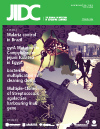Ten-year surveillance of invasive Streptococcus pneumoniae isolates in central Turkey prior to the introduction of a conjugate vaccine
DOI:
https://doi.org/10.3855/jidc.834Keywords:
Streptococcus pneumoniae, vaccine, serotyping, antimicrobial susceptibilityAbstract
Introduction: The aim of this study was to characterize the serotypes and antimicrobial susceptibility patterns of invasive Streptococcus pneumoniae isolates in central Turkey.
Methodology: A total of 332 invasive S. pneumoniae isolates were identified, serotyped and tested for antimicrobial susceptibility by routine microbiological methods.
Results: The most common serogroups/serotypes were 1, 19, 3, 18, 6, 14, and 7 in rank order. Serogroup/serotype coverage of the 23-valent polysaccharide vaccine, and the 7-, 10-, and 13-valent conjugate vaccines were 96%, 44%, 78.6%, 96.4%, respectively. Overall, 20 (6%) of the isolates were resistant to penicillin, 1 (0.3%) to cefotaxime, 20 (6%) to erythromycin, 13 (4%) to cloramphenicol, and 120 (36%) to trimethoprim-sulfamethoxasole. Among cerebrospinal fluid (CSF) isolates, 20 (18.5%) were resistant to penicillin (26.3% and 11.5%, respectively, of child and adult meningitis cases; p≥0.05).
Conclusions: Although the seven-valent conjugate vaccine is expected to protect less than half of children younger than three years of age, of the incorporation of this vaccine into the routine immunization program of Turkey is advised to continue. However, the 13-valent conjugate vaccine, including serotypes 1, 3, 5, and 7, has the most potential prevent the highest burden of invasive pneumococcal diseases in this age group.
Downloads
Published
How to Cite
Issue
Section
License
Authors who publish with this journal agree to the following terms:
- Authors retain copyright and grant the journal right of first publication with the work simultaneously licensed under a Creative Commons Attribution License that allows others to share the work with an acknowledgement of the work's authorship and initial publication in this journal.
- Authors are able to enter into separate, additional contractual arrangements for the non-exclusive distribution of the journal's published version of the work (e.g., post it to an institutional repository or publish it in a book), with an acknowledgement of its initial publication in this journal.
- Authors are permitted and encouraged to post their work online (e.g., in institutional repositories or on their website) prior to and during the submission process, as it can lead to productive exchanges, as well as earlier and greater citation of published work (See The Effect of Open Access).








